Accepted Scientific Name: Echinomastus johnsonii (Parry ex Engelm.) E.M.Baxter in E.M.Baxter
Calif. Cact. 75. 1935 E.M.Baxter
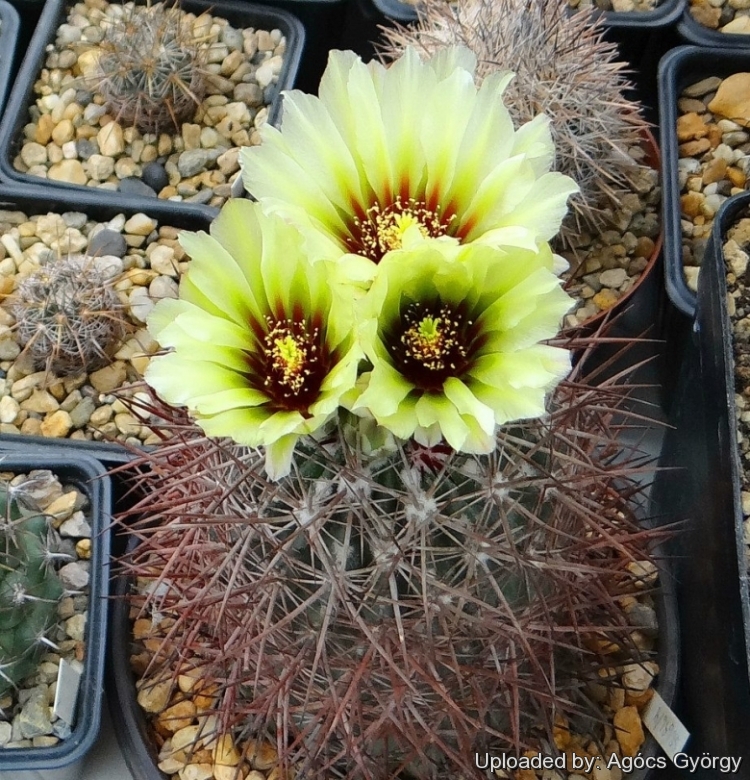
Echinomastus johnsonii var. lutescens Photo by: Agócs György
Rebutialand - Cactus collection.
Origin and Habitat: The Echinomastus johnsoni is found in Eastern California, southern Nevada, Utah and western Arizona. The yellow flowered and the pink-flowered plants occur in separate populations, as far as is known, the pink-flowered plants occur to the north of the yellow-flowered plants.
Habitat: Mojave desert scrub and upper edge of Sonoran desert scrub, rocky slopes, gravelly hills.
Synonyms:
See all synonyms of Echinomastus johnsonii
back
Accepted name in llifle Database:Echinomastus johnsonii (Parry ex Engelm.) E.M.Baxter in E.M.BaxterCalif. Cact. 75. 1935Synonymy: 12
back
Common Names include:
ENGLISH: Chartreuse Pineapple Cactus, Johnson's Pineapple Cactus, Pineapple Cactus, Pink Viznaga, Johnson's Fishhook Cactus, Johnson's Beehive Cactus, Eight-spine Fishhook Cactus, Johnson's Barrel Cactus, Pygmy Barrel Cactus
Description: Echinomastus johnsoniiSN|14880]]SN|14880]] is a small barrel cactus densely covered by yellow, pinkish, reddish or greyish lavender to maroon spines, with flowers ranging in colour from magenta to pink to greenish yellow. The yellow-flowered plants have been named Echinomastus johnsoniiSN|14880]]SN|14880]] var. lutescens.
Stems: Usually solitary, ovoid to cylindrical, 10-25 cm high, 5-10(-15 ) cm in diameter, densely covered by spines.
Ribs: (13-)17-21, strongly indented above each tubercle and then rising gradually to the next. Tubercles distinct, about 6 mm high. Areoles 15-26 mm apart along ribs; areolar glands present at least seasonally.
Central spines: 4-9, pale yellow, pinkish, reddish or grayish lavender to maroon, becoming darker with age, straight to strongly decurved; abaxial central spine porrect, spreading, 3-4 cm long.
Radial spines: 9-10(-16) per areole, lighter in color, spreading, 1,2-2(-4) cm long; abaxial (shortest).
Flowers: Funnelform, magenta, pink, or greenish yellow , basal portions blotched with maroon, 4-6 cm long, 5-7,5 cm in diameter. Stigma lobes yellowish white to green.
Blooming season (in habitat): (Feb-) Mar-May
Fruits: Spherical 17-18 mm green, becoming tan at maturity, dehiscing vertically only along single, longitudinal split. Fruiting Apr-Jun.
Chromosome number 2n = 22.
Subspecies, varieties, forms and cultivars of plants belonging to the Echinomastus johnsonii group
 Echinomastus johnsonii (Parry ex Engelm.) E.M.Baxter in E.M.Baxter: is a small “barrel cacti” almost completely hidden by the interlocking spines. It includes plants quite variable in flower and spination colors.
Echinomastus johnsonii (Parry ex Engelm.) E.M.Baxter in E.M.Baxter: is a small “barrel cacti” almost completely hidden by the interlocking spines. It includes plants quite variable in flower and spination colors. Echinomastus johnsonii var. lutescens (Parish) Wiggins in Shreve & Wiggins: Yellow-flowered.
Echinomastus johnsonii var. lutescens (Parish) Wiggins in Shreve & Wiggins: Yellow-flowered.
Bibliography: Major references and further lectures
1) Edward Anderson “The Cactus family” Timber Press, Incorporated, 2001
2) James Cullen, Sabina G. Knees, H. Suzanne Cubey "The European Garden Flora Flowering Plants: A Manual for the Identification of Plants Cultivated in Europe, Both Out-of-Doors and Under Glass" Cambridge University Press, 11/Aug/2011
3) David R Hunt; Nigel P Taylor; Graham Charles; International Cactaceae Systematics Group. "The New Cactus Lexicon" dh books, 2006
4) Brian Loflin, Shirley Loflin “Texas Cacti: A Field Guide” Texas A&M University Press, 26/ott/2009
5) Albert Michael Powell, James F. Weedin “Cacti of the Trans-Pecos and Adjacent Areas” Texas Tech University Press, 2004
6) Del Weniger “Cacti of the Southwest: Texas, New Mexico, Oklahoma, Arkansas, and Louisiana” University of Texas Press, 1969
7) “Rare Plants of Texas: A Field Guide” Texas A&M University Press, 2007
8) Roland H. Wauer, Carl M. Fleming “Naturalist's Big Bend: An Introduction to the Trees and Shrubs, Wildflowers, Cacti, Mammals, Birds, Reptiles and Amphibians, Fish, and Insects“ Texas A&M University Press, 2002
9) Butterworth, C., Baker, M. & Porter, J.M. 2013. Sclerocactus johnsonii. In: IUCN 2013. "IUCN Red List of Threatened Species." Version 2013.2. <www.iucnredlist.org>. Downloaded on 06 April 2014.
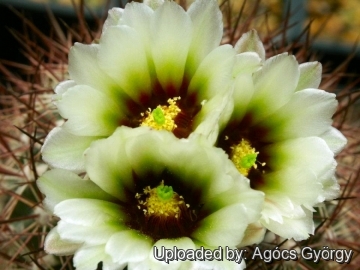 Flowers. Rebutialand cactus collection Demjén, Hungary. Photo by: Agócs György
Flowers. Rebutialand cactus collection Demjén, Hungary. Photo by: Agócs György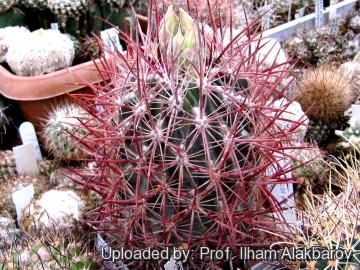 - The stem of this fascinating cactus is almost completely hidden by the interlocking grey-pink, grey-red to grey-brown spines except for the apex that is more or less devoid of spines, but with a heavily felted-over circular patch 1-1,5 cm in diameter. Photo by: Prof. Ilham Alakbarov
- The stem of this fascinating cactus is almost completely hidden by the interlocking grey-pink, grey-red to grey-brown spines except for the apex that is more or less devoid of spines, but with a heavily felted-over circular patch 1-1,5 cm in diameter. Photo by: Prof. Ilham Alakbarov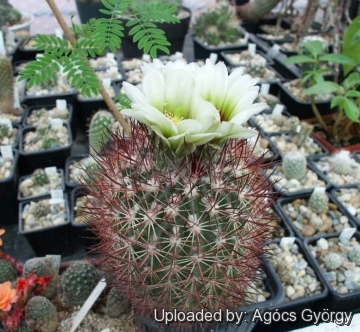 Flowering habit. Rebutialand cactus collection Demjén, Hungary. Photo by: Agócs György
Flowering habit. Rebutialand cactus collection Demjén, Hungary. Photo by: Agócs György Echinomastus johnsonii var. lutescens Photo by: Valentino Vallicelli
Echinomastus johnsonii var. lutescens Photo by: Valentino Vallicelli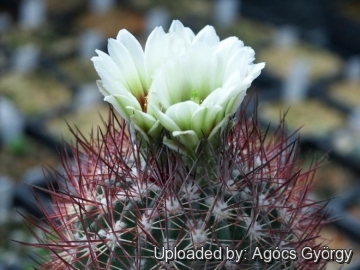 Rebutialand cactus collection Demjén, Hungary. Photo by: Agócs György
Rebutialand cactus collection Demjén, Hungary. Photo by: Agócs György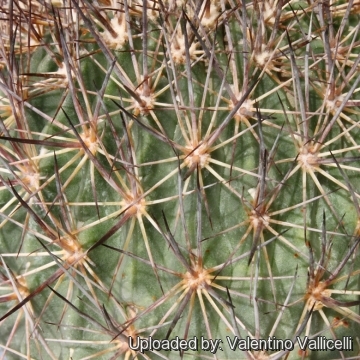 Echinomastus johnsonii var. lutescens Photo by: Valentino Vallicelli
Echinomastus johnsonii var. lutescens Photo by: Valentino Vallicelli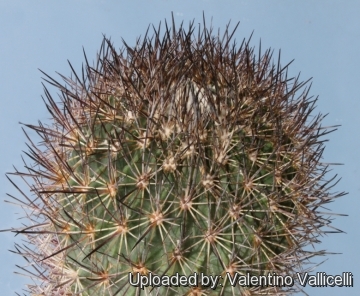 Echinomastus johnsonii var. lutescens Photo by: Valentino Vallicelli
Echinomastus johnsonii var. lutescens Photo by: Valentino VallicelliSend a photo of this plant.The gallery now contains thousands of pictures, however it is possible to do even more. We are, of course, seeking photos of species not yet shown in the gallery but not only that, we are also looking for better pictures than those already present.
Read More... Cultivation and Propagation: This is one of the most beautiful cacti but rarely seen in cultivation, it needs perfect drainage to flourish. It is quite difficult to grow on its own roots. Very easily rot! It’s thought that’s better to watch this species in photo or in the natural habitat rather than to try to cultivate it. For this reasons the plant is often grafted on a frost hardy stock.
This plant need full sun and above all a very good ventilation, especially in winter. Keep totally dry during winter. It can tolerate temperature below zero (-15° C or less). Mature individuals - if the growing conditions are not optimal, easily rot and die.
Propagation: Seeds are relatively difficult to germinate (only a limited percentage of seeds germinate). Grafting is often used to speed growth rate and to create a back-up for plants in collection.

















